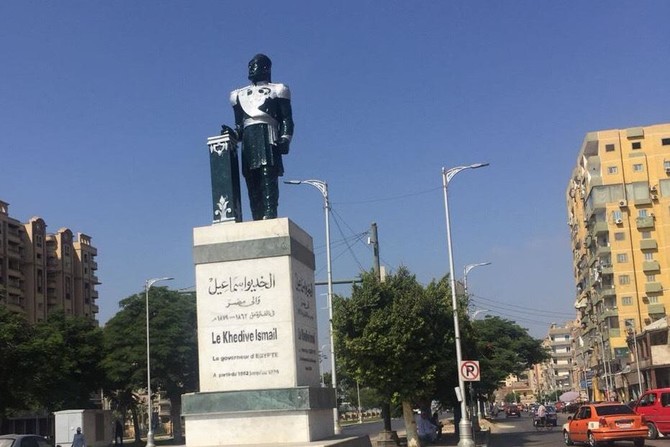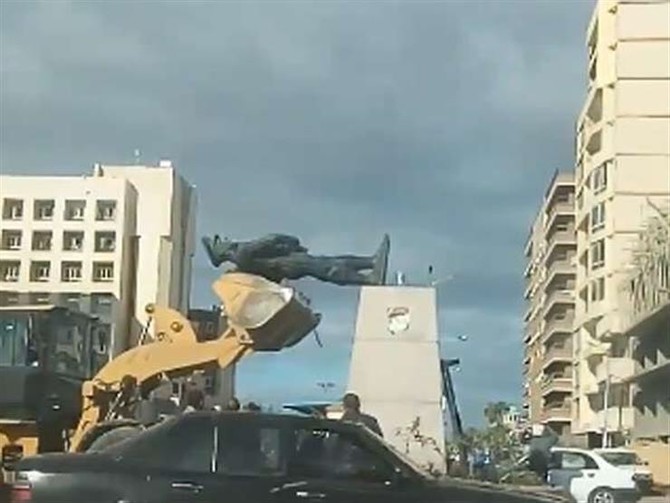http://www.arabnews.com/node/1361351/middle-east
Bungled statue restorations bring Egypt's great and good down to size
- In Egypt, a series of representations of the country's great and good, have become objects of ridicule after local authorities carried out botched restoration work
- Egyptian Culture Minister Inas Abdel Dayem has formed a committee composed of arts experts to investigate
EGYPT: They are supposed to be symbols of greatness, odes to the successful, musings on the powerful.
A towering bronze cast of a leading thinker or a once great military general hued from marble is designed to stir emotions of respect, national pride or a moment of introspection.
But in Egypt, a series of representations of the country's great and good, have become objects of ridicule after local authorities carried out botched restoration work.
The bronze statue of Khedive Ismail Pasha, the 19th Century Ottoman ruler of Egypt and Sudan, is the latest to fall foul of cack-handed workmen.
The statue shows the leader, who oversaw a great modernization of the country, standing proudly in his uniform. But the figure has been clumsily painted over in black and white, making the once great Khedive appear more like a character in a B-movie horror picture.
Images of the statue have been widely circulated and ridiculed on social media in Egypt. The statue, located in the city of Ismailia, has also drawn angry comments from the community as well as Egyptian officials.
Egyptian Culture Minister Inas Abdel Dayem has formed a committee composed of arts experts and the national organization of civilization at the Ministry of Culture to investigate what went wrong with the restoration work.
"The ministry stands against all attempts to distort the public statues and will work to restore the statue to its origin," Abdel-Daeem said.
The Governor of Ismailia, Yassin Tahir, has launched an urgent investigation to find out who was responsible. He stressed that the statue symbolizes the history of Ismailia, and commissioned cultural officials in the province to coordinate with officials of the Ministry of Culture and to restore the statue to its original color and preserve its historical character.
"This statue uses special materials for paint, which we have used since it was erected in 2006, and we use it annually in the maintenance process. However, developers this year used these materials incorrectly," he said.
The statue is located at the intersection of Al-Thalathini and Mohammed Ali Street and the entrance to Al-Blajat Road. About 7m tall, it stands on a 2m platform.
It is not the first time there has been controversy over the treatment of statues representing Egyptia historical figures in recent years. Last April, there was anger when four statues in Alexandria of Egyptian icons were moved in a rubbish van and a lorry.
One depicted Hassan Al-Iskandarani, known as the Prince of the Sea, another was of Sayed Darwish, the Egyptian musical pioneer, Abdullah Al-Nadim, one of the leaders of the Oraby Revolution in 1881, and Refaa Al-Tahtawi, a famous education reformer.
In another incident, a statue of the Martyr Abdel Moneim Riad, a former general of the Egyptian army, was fractured while being transported in Port Said. An investigation was launched and the governor had to apologize to the general's family. The district chief responsible at that time lost his job.
The incident took place at a time when parliament was passing a bill to criminalize insults to historical symbols in Egypt, increasing the punishment to up to five years' imprisonment.
In 2016, former prime minister Sharif Ismail banned the restoration of statues without the consent and cooperation of the Ministry of Culture and Antiquities.
The decision came after a crisis caused by a statue called "Mother of the Martyr" in September 2016 in Sohag, 400km south of Cairo, showing a soldier embracing a woman from behind. It was criticized on social media for showing sexual harassment.
There was also anger in Aswan after restoration work to a figure of the famous writer Abbas Mahmoud Al-Akkad in November 2015 led to its disfigurement.
In Zagazig, the statue of Ahmed Oraby, the historical leader, was widely mocked after officials turned it green during a restoration.
The statue of Rifa'a Al-Tahtawi, an Egyptian scholar, in Tahta in the Sohag governorate, was condemned as unrecognizable by citizens of the city.
-- Sent from my Linux system.



No comments:
Post a Comment